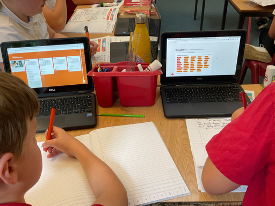Visit 1 - Activity 4
Writing the beginning of a story
Context
12.55-13:30
Immediately after Activity 3, children pick up their writing books, which by now contain their glued in writing plans. Several children have their Chromebook open. The teacher has explained the activity and children are excited to start writing the beginning of their stories.
Key activities
- Children individually write the beginnings of their story in their writing books
- Children use a variety of digital resources (Padlets, thesaurus, film, IWB, Google Drive) to support and structure their drafting
- To write an interesting opening of a story
- To write from one character’s perspective
- Interactive WhiteBoard
- Chromebooks with:
- Padlets
- Thesaurus
- Story exemplar in shared folder
- Oktapodi film
- Scaffolding the writing process using digital resources
- Scaffolding new learning through reference to wall display
- Collaboratively learning from one another
- Sharing ideas with the rest of the class
- Recount of understanding about writing
- Explanation of ideas to peers
- Reading wall display
- Shifting attention between various digital and non-digital resources
- Write beginning of story in writing books (pen and paper)
- Are children engaged and do they seem to enjoy the activity?
- Does the multimedia technology help support and sustain engagement in writing?
- Can children shift easily between the various technologies available and their pen and paper task?

Lesson Commentary
Introduction
Immediately after Activity 3, the children excitedly start their writing. Several Chromebooks are opened up on the desks, and children all talk to one-another about their stories. The teacher begins by asking for an example of an opening sentence
- High levels of excitement (chatter/ noise/ movement) as children focus on their activity, shifting to collaborative chatter, supporting the learning
- Collaboration is promoted by the use of the Chromebooks and Padlet
- Children’s focus shifts easily from Chromebook, to partner, to non digital resources, to partner’s Chromebook
- As previously, the use of digital and more formal writing resources and activities are blended to scaffold the children
- Children with SEND actively use the prompts provided by the software to propel their composition
- The children own the writing process. They are in a state of ‘flow’ and are finding it hard to stop for a break
- Presenting an example opening of a story gave children confidence with what they had to do
- Children appear fully invested in their story. They are serious about their writing work and recognise one-another's achievements when sharing outputs
- Extended time is needed to build to the point where children can function independently as storywriters, having used a range of digital and non-digital resources
- Individual ownership of technologies (e.g. Chromebooks) leads to independent use over time
- Composing narrative with digital resources involves the construction of an holistic storywriting world that is complex and can involve resources and activities developed over time, and in a range of modes and formats
- Children will occupy different roles as a ‘writers’, as they build towards composing a definitive piece of narrative (collaborator, feedback giver and receiver, curator, solitary composer, actor in role, writer in role, story participant, story watcher, discoverer)
- The teacher will occupy different roles when working across digital and traditional resources to promote narrative writing
- Children will need to draw on explicitly taught skills-based knowledge, e.g. pathetic fallacy, character study, which may be developed using traditional pedagogies for writing
- Digital resources and traditional resources/ activities can be blended to scaffold narrative writing
